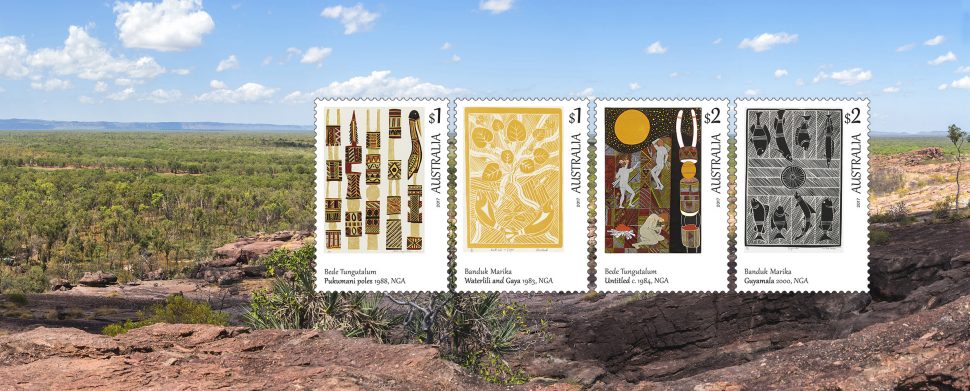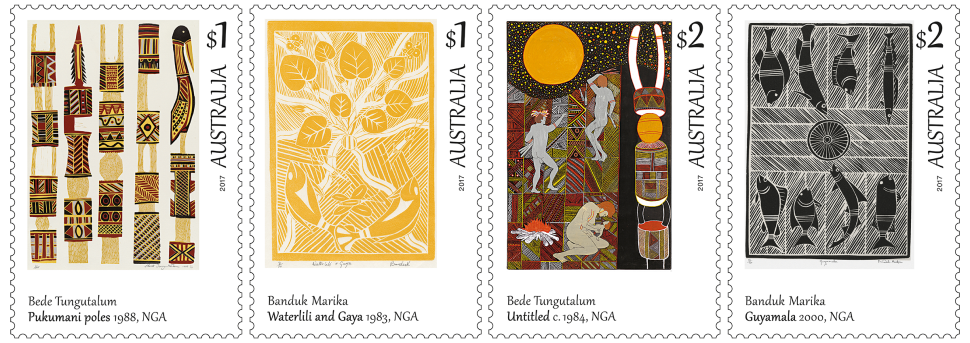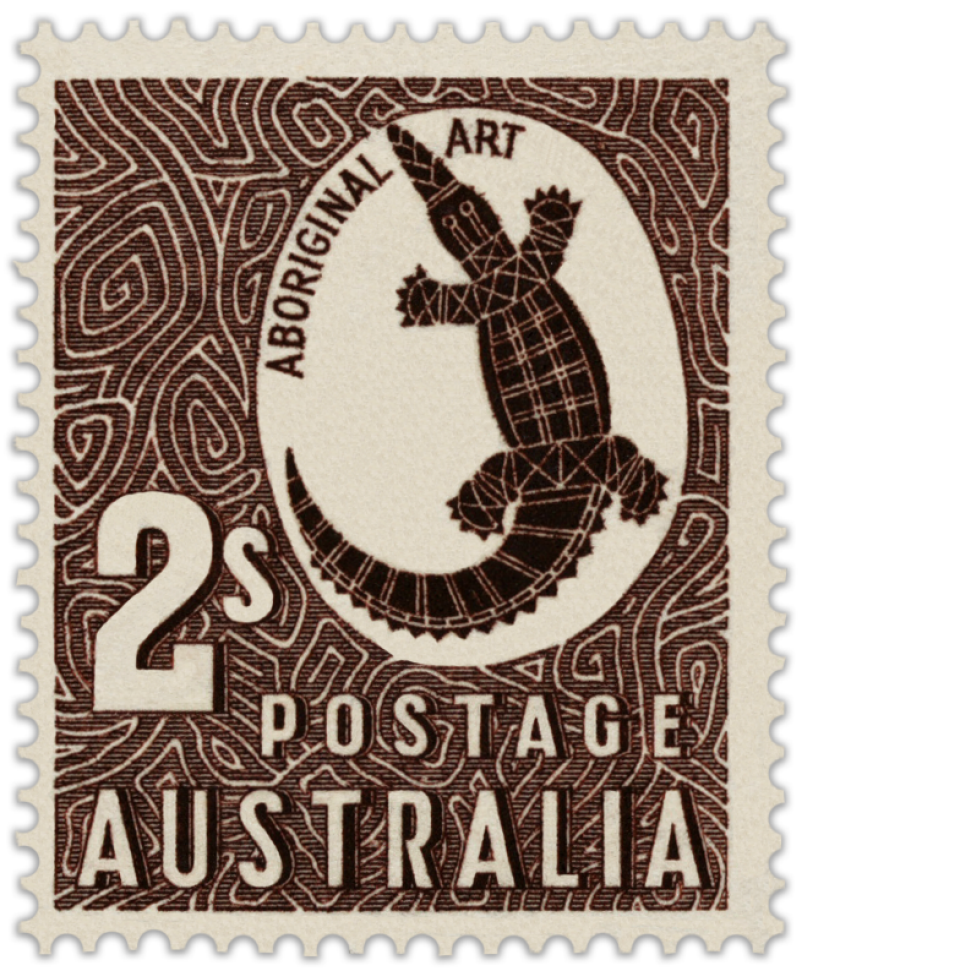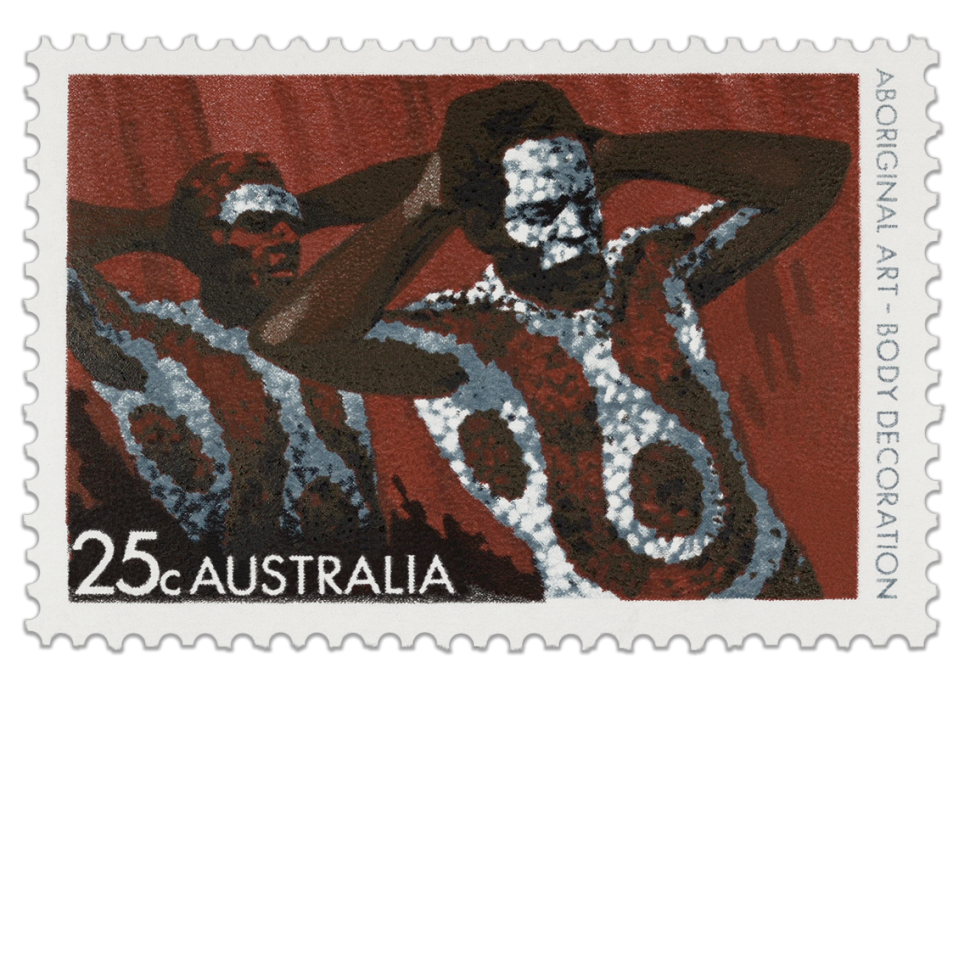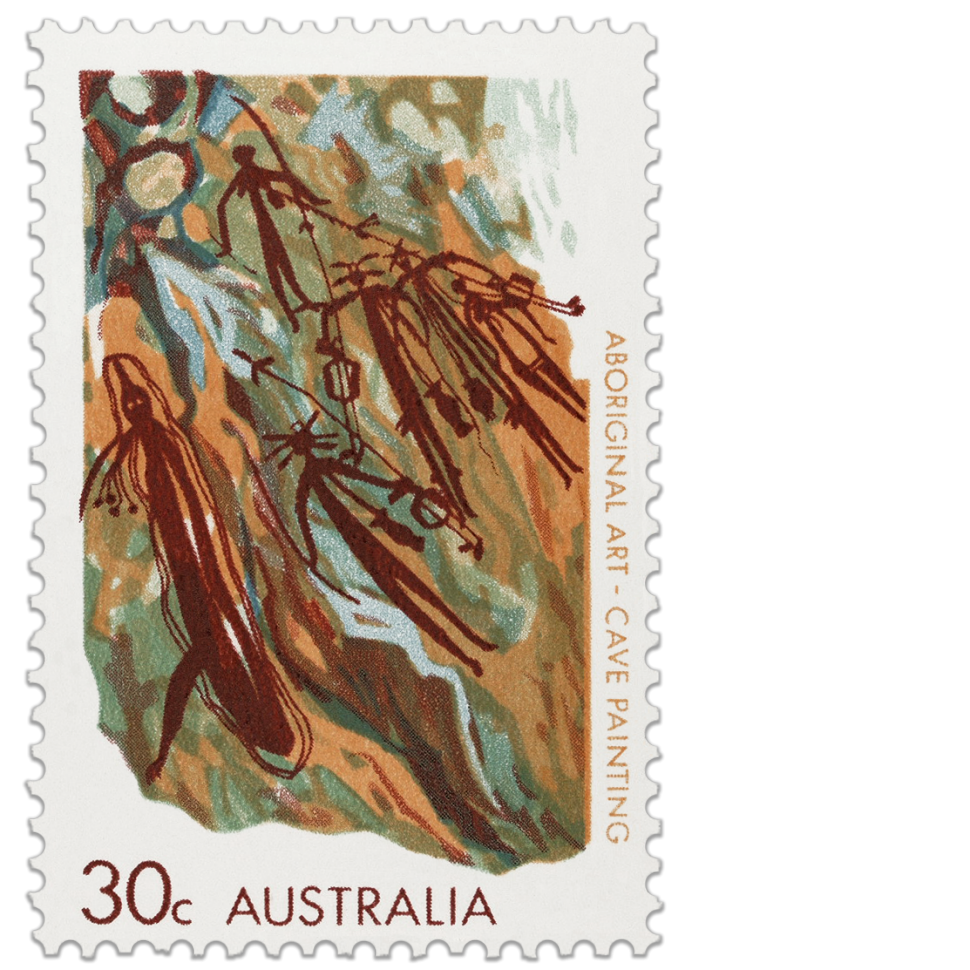The culture of Indigenous Australia is ancient and rich, encompassing oral storytelling and language, important ceremonies and artefacts, sacred sites, music, dance and visual art.
Australia Post has produced many stamps recognising Aboriginal and Torres Strait Islander people, culture and stories, including, most recently, the 2017 Australian Legends stamp issue. This features three renowned Indigenous leaders released on 24 October, Art of the North. The latter is a special issue of four stamps features works by two eminent artists from the northern regions of Australia’s Northern Territory, Banduk Marika and Bede Tungutalum. Learn more about the artists and artwork.
The stamps, designed by Lynette Traynor of the Australia Post Design Studio, feature two works from each artist. All works are part of the collection of the National Gallery of Australia.
1948 Australian Animals stamp issue
The first Australian stamp to feature an Indigenous art theme was released in 1948. It was a 2 shilling stamp representing a crocodile, in the style of a rock painting, as part of the Australian Animals definitive stamp issue of that year. However, this was not an artwork by an Indigenous artist. Sydney artist Gert Sellheim entered a competition in 1946 for Australian stamp designs.
The Postmaster-General at the time wanted to generate Australian themes on higher value stamps. A special judging panel picked eight designs as winners but of the eight designs, only two were issued as stamps, including Sellheim’s. The judging panel went on to become Australia Post’s first Stamp Advisory Committee, commencing in 1947.
1971 Aboriginal Art stamp issue
The first stamp issue to focus on traditional, authentic Indigenous art forms was released on 29 September 1971 and titled Aboriginal Art. The stamp issue came about in the context of a change in policy relating to definitive stamps. The resulting stamp issue, while focusing on traditional arts forms, was not yet focused on the artist. This came later, in 1988, with the Art of the Desert stamp issue and has remained the focus of future Indigenous art-related stamp issues.
Prior to the middle of 1968, definitive stamps were replaced after around three years, which was proving difficult in terms of allowing the stamp program to accommodate the public’s many stamp themes suggestions. A new policy allowed for shorter-term definitive stamps. These stamps would be released in sets of three or four and remain on sale for approximately three months. The first stamp issue proposed under this policy was the 1969 stamps featuring primary industries (the first short-term definitive issue). The second was a suggested issue on Aboriginal bark paintings, which over time was expanded to Aboriginal art more broadly. The concept of short-term definitive stamps didn’t work well; the rate changes were too frequent at that time, so some of the short-term definitives ended up becoming longer-term definitives anyway.
By June 1970, it was decided that these new short-term definitive stamps would be on sale for six months, effectively serving as a forerunner to our current-day commemorative and special issue stamps. However, in the end, the Aboriginal art issue was released as a long-term definitive stamp issue, due to a change in overseas airmail rates. Three of the stamps (20c, 25c and 30c) were issued to replace existing definitive stamps depicting Australian native flowers. The fourth stamp presented a new denomination of 35 cents. These denominations were selected to correspond with the international mail rates, to allow the artworks to be viewed all over the world.
After the broad subject matter was determined for each stamp, consultations began with the Museum of Victoria and the Australian Institute of Aboriginal Studies in Canberra (now known as the Australian Institute of Aboriginal and Torres Strait Islander Studies). The institute excluded two of the initial selections due to the sacred nature of the rituals depicted.
The final designs, by John Mason, were in the then larger gravure size of (38mm x 25.5mm in landscape and 25.5mm x 38mm in portrait).
20c Bark Painting
A bark painting of a long-necked tortoise from West Arnhem Land in the Northern Territory. The transparency used was from the collection of A L West, a then curator in anthropology at the Museum of Victoria. The canvas is bark paintings usually comes from a stringy bark gum tree. Traditionally, a knot-free section of the tree is selected cut from near the base of the tree. It is heated over a fire to make it pliable and then flattened under a rock or log.
25c Body Decoration
A depiction of the decoration used in the final mourning ceremony by the Warramunga people, from the Tennant Creek area in the Northern Territory. The photograph was also from the collection of Museum Victoria, taken by the late Sir Baldwin Spencer. The original image selected was changed during the design process, as the initial design depicted two men in the act of painting each other, which the Australian Institute of Aboriginal Studies determined was a sacred ceremony to be only witnessed by men. However, the ceremony depicted in the final design could also be viewed by women.
25c Body Decoration
A depiction of the decoration used in the final mourning ceremony by the Warramunga people, from the Tennant Creek area in the Northern Territory. The photograph was also from the collection of Museum Victoria, taken by the late Sir Baldwin Spencer. The original image selected was changed during the design process, as the initial design depicted two men in the act of painting each other, which the Australian Institute of Aboriginal Studies determined was a sacred ceremony to be only witnessed by men. However, the ceremony depicted in the final design could also be viewed by women.
The Art of the North stamp issue is available from 24 October, online, at participating Post Offices and via mail order on 1800 331 794, while stocks last.
View the gallery of stamps and technical specifications for this issue
This article was produced at the time of publication and will not be updated.
